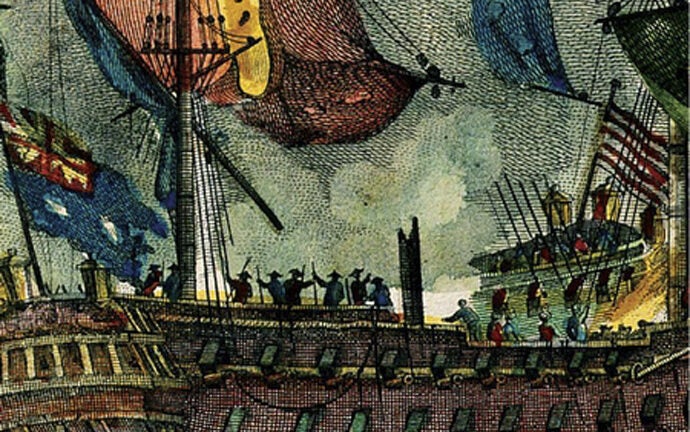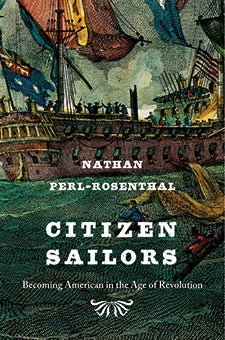
American Identity at Sea
“Now sir, you are dished!”
These were the mocking words an 18th-century British boatswain addressed to a captured American sailor as he ripped up the seaman’s identity papers and tossed them overboard.
This incident, which the sailor cited in a letter complaining about his treatment at the hands of the British Navy, occurred two decades after the end of the American Revolutionary War. It is one of many descriptions of tribulations faced by American sailors during this period that Nathan Perl-Rosenthal recounts in his upcoming book Citizen Sailors — a work brimming with swashbuckling maritime drama.
“In the decades after the U.S. formally declared independence in 1776, Americans struggled to gain recognition of their new republic and their rights as citizens,” writes Perl-Rosenthal, assistant professor of history and spatial sciences at USC Dornsife. “None had to fight harder than America’s sailors, whose profession took them far from home and deep into an often hostile Atlantic world.”
The protective shield of American citizenship
Citizen Sailors takes readers on a chronological journey through the birth of the early modern world at the start of the 18th century — a time when nationality was determined largely by the language an individual spoke, where status mattered more than nationality and identity papers were virtually nonexistent — to the close of the century when American sailors finally won the right to carry papers issued by the United States federal government, identifying them as American citizens.

Nathan Perl-Rosenthal’s first book Citizen Sailors is brimming with swashbuckling maritime drama.
Before they had identity papers, American sailors captured by enemy ships often struggled to identify themselves as Americans. While Americans might be jailed by the British, they would rarely be executed. Being perceived to be British, however, was much riskier. Without papers to prove their citizenship, American sailors had to resort to their powers of persuasion to convince their captors they were not British citizens fighting on the side of the Americans — an act of treason that spelled almost certain death.
“Once Britain recognized American Independence in 1783, being an American became protective because the U.S. was not directly involved in any of the wars that raged almost continuously from the 1780s to 1830,” Perl-Rosenthal said. “If you could prove you were American, you were much safer than if you were a British or French subject during this period.”
Once they won their long fight to obtain identity documents, also known as protection papers, American sailors still faced numerous challenges. British captains’ fondness for tearing up the cherished paperwork was just one of many risks American sailors faced on long sea voyages. Others included the propensity of mice and rats to shred paper and saltwater to rot it.
“The importance sailors attached to these identity documents can be seen in the efforts they made to preserve them by gluing heavier stock or newspaper on to the back of them and making little wallets to carry them in,” said Perl-Rosenthal.
A passionate interest revisited
The idea for the book, which will be published by The Belknap Press of Harvard University Press in October 2015, grew out of a project that had fascinated Perl-Rosenthal as an undergraduate at Harvard. When he arrived at USC in 2011, he returned to that project.

Nathan Perl-Rosenthal, assistant professor of history and spatial sciences. Photo by Peter Zhaoyu Zhou.
“I was interested in what new and interesting things sailors could tell us about the history of citizenship and the making of modern citizenship and nationality, which is an essential quality of life today,” he said. “We only have to look at the news and the huge refugee crisis in the Mediterranean to see a current nationality crisis.”
Perl-Rosenthal said USC Dornsife had been crucial in enabling him to write the book.
“In the humanities it’s very unusual to write one’s dissertation on one thing and a first book on something else, but my senior colleagues at USC Dornsife were remarkably accepting and encouraging,” he said. “The Early Modern Studies Institute, Visual Studies Research Institute and Spatial Studies Institute were all amazingly supportive. I don’t know if could have written this book anywhere else and I am profoundly grateful for that.”
Bridging racial barriers
Perl-Rosenthal said the most amazing and moving aspect of his research was exploring how these protection certificates of nationality, identity and citizenship were granted in large numbers to African American sailors.
“Thousands of African American sailors were being given these citizenship papers around 1803 at a time when African American citizenship in the U.S. was very tenuous,” Perl-Rosenthal said. “There were many states where African Americans … could not be citizens. So to see the Federal government in this period publicly acknowledging and certifying the citizenship of African Americans is remarkable.”
As an example of the power these documents had, Perl-Rosenthal cites the history of one of the most famous 19th-century abolitionists, Frederick Douglass. Originally a slave himself, he borrowed an African American sailor’s protection certificate to pass as a freeman and escape from Maryland to New York and then New Bedford in 1838.
“Even then, these papers still had the power to help liberate someone who then went on to become a great American orator and figure and a leading light of this crucial 19th-century protest movement.”